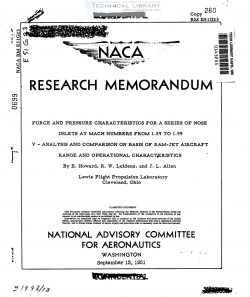naca-rm-e51g23
- Version
- 52 Downloads
- 1.28 MB File Size
- 1 File Count
- May 25, 2017 Create Date
- May 25, 2017 Last Updated
National Advisory Committee for Aeronautics, Research Memorandum - Force and Pressure Characteristics for a Series of Nose Inlets at Mach Numbers from 1.59 to 1.99 - V - Analysis and Comparison on Basis of Ram Jet Aircraft Range and Operational Characteristics

Four specific designs of axially symmetric spike-type nose inlets
were investigated in the NAGA Lewis 8- by 6-foot supersonic wind tunnel
at flight mach numbers from 1.59 to 1.99 and at angles of attack from
00 to 10°. The inlets, designed to operate at a flight Mach number of
1.80, were: an external compression inlet having a relatively blunt
or subsonic leading e(subsonic lip inlet), an isentropic spike
inlet having all—ext compression (isentropic inlet), an external
compression inlet with a relatively sharp lip and low cowl slope
(supersonic lip inlefiT; and an external-internal compression inlet
utilizing a perforated cowl (perforated inlet). In this report, the
inlets were compared on the basis of the effect of inlet characteristics
on ramrJet-engine aircraft range and operational problems. The effects
of a burner and exhaust nozzle were analytically added to the experi—
mental cold flow inlet data.
At the design flight Mach number, the maximum airgraft range based
on calculated peak engine efficiencies varied '25 percent from the
highest value, which indicates the importance of inlet design. The
supersonic lip inlet had the highest calculated engine efficiency, the.
second highest pressure recovery, and the lowest drag of the four inlets
investigated. The low drag was associated with a minimum of additive
drag (minimum mass spillage) and a low cowl lip angle.
Calculations for a typical supersonic aircraft indicated some
increase in range might be obtained from engines utilizing any of the
inlets except the perforated inlet if the engine were flown at a mod-
erate angle of attack.and the resulting engine lift were utilized.
Evaluation at off-design conditions for an engine optimized for
maximum aircraft range (peak engine efficiency) at the design point
indicated that propulsive thrust increased with increasing heat addition
in the subcritical flow region in spite of the increasing additive drag.
For angles of attack of 5° and 6°, the trends of excess thrust with
increasing heat addition were similar to those at 0°. For the perfo—
rated inlet, there was a range of tota1-temperature ratios in the sub-
critical flow region where, owing to mass spillage through the perfo-
rations, increasing the temperature ratio did not yield an increase in
propulsive thrust.
Speed stability of a.ram-Jet-propelled aircraft could be attained
with peak engine efficiency at deSign cruise conditions by means of a
fuel flow programmed with flight Mach number for all the inlets except
the perforated inlet.
| File | Action |
|---|---|
| naca-rm-e51g23 Force and Pressure Characteristics for a Series of Nose Inlets at Mach Numbers from 1.59 to 1.99 - V - Analysis and Comparison on Basis of Ram Jet Aircraft Range and Operational Characteristics.pdf | Download |

Comment On This Post